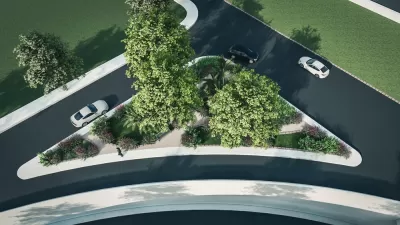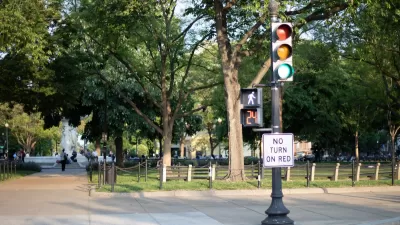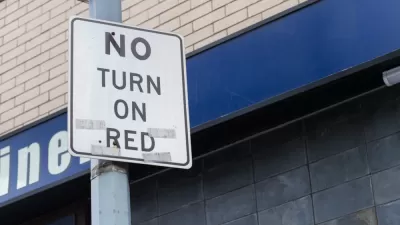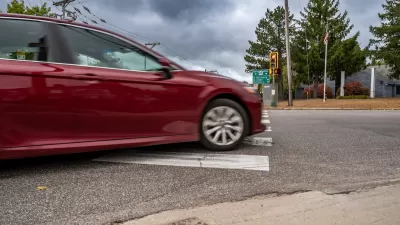Right-turn lanes can make traffic flow more smoothly, but make roadway conditions more dangerous for pedestrians and other road users on non-motorized vehicles.

"There is one roadway design feature that is becoming a point of contention in many communities and you’ve probably driven or walked through one at least once," writes Sam McCrory of the slip lane. Also known as channelized right-hand turn lanes, "Slip lanes are separate turn lanes that allow cars to make a right-hand turn without fully stopping for a red light at an intersection," McCrory explains.
If people driving are allowed to make an unimpeded right-hand turn, engineers believe that congestion will decrease. Slip lanes are also implemented for other reasons, like vehicle safety and consideration for larger vehicles. Slip lanes do help reduce t-bone style vehicle crashes, which are typically more dangerous to people driving; and because of their wide turning angle, slip lanes are more favorable for larger vehicles like semis, emergency vehicles, and delivery trucks to make turns in urban areas.
But there's one significant catch, writes McCrory. Slip lanes "are extremely dangerous for people using non-motorized means of transportation (walking, biking, etc)." According to the article, "In many scenarios slip lanes are completely useless and only cause confusion and negative safety outcomes for people using them. A simple way to increase safety is simply to stop implementing them."
McCrory recommends repurposing slip lane space "for things like bus stops, outdoor seating/gathering places, green space, and other uses," illustrating several potential examples at St. Louis intersections where slip lanes could serve more people-friendly purposes.
FULL STORY: IMAGINING ST. LOUIS WITHOUT SLIP LANES

Trump Administration Could Effectively End Housing Voucher Program
Federal officials are eyeing major cuts to the Section 8 program that helps millions of low-income households pay rent.

Planetizen Federal Action Tracker
A weekly monitor of how Trump’s orders and actions are impacting planners and planning in America.

Ken Jennings Launches Transit Web Series
The Jeopardy champ wants you to ride public transit.

Washington Legislature Passes Rent Increase Cap
A bill that caps rent increases at 7 percent plus inflation is headed to the governor’s desk.

From Planning to Action: How LA County Is Rethinking Climate Resilience
Chief Sustainability Officer Rita Kampalath outlines the County’s shift from planning to implementation in its climate resilience efforts, emphasizing cross-departmental coordination, updated recovery strategies, and the need for flexible funding.

New Mexico Aging Department Commits to Helping Seniors Age ‘In Place’ and ‘Autonomously’ in New Draft Plan
As New Mexico’s population of seniors continues to grow, the state’s aging department is proposing expanded initiatives to help seniors maintain their autonomy while also supporting family caregivers.
Urban Design for Planners 1: Software Tools
This six-course series explores essential urban design concepts using open source software and equips planners with the tools they need to participate fully in the urban design process.
Planning for Universal Design
Learn the tools for implementing Universal Design in planning regulations.
Heyer Gruel & Associates PA
Ada County Highway District
Institute for Housing and Urban Development Studies (IHS)
City of Grandview
Harvard GSD Executive Education
Toledo-Lucas County Plan Commissions
Salt Lake City
NYU Wagner Graduate School of Public Service





























